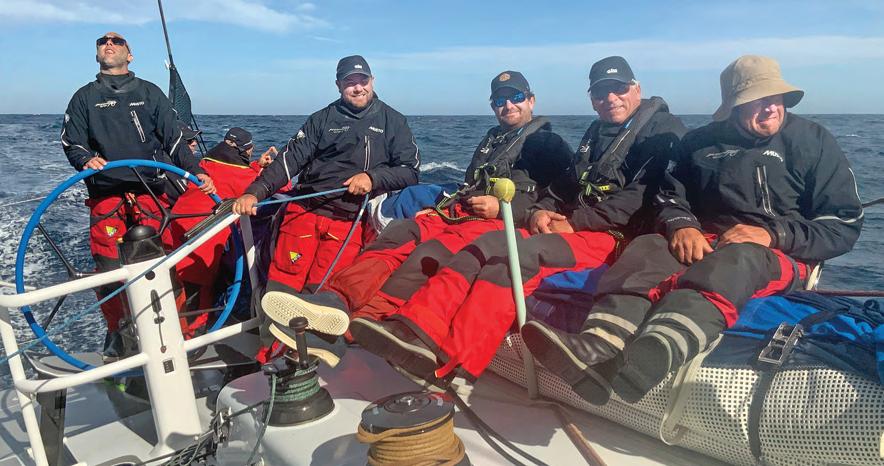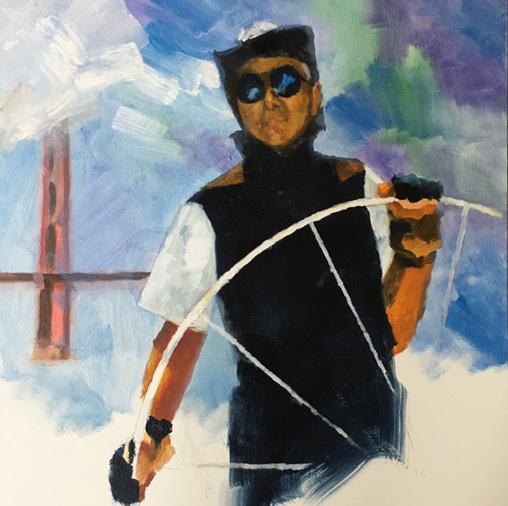
10 minute read
pyewacket destroys cabo record
PYEWACKET 70
ALL PHOTOS COURTESY PYEWACKET
'Pyewacket 70' — not to be confused with Roy Disney's other 'Pyewacket', an Andrews 70 — is a modified Volvo 70.
Newport Harbor Yacht Club has hosted the biennial Newport to Cabo San Lucas Race since 1971. This year's 21st edition was perhaps not what the founders had in mind when they set out to create an 800-mile yacht race ideal for sailors "of all levels." Friends and families were encouraged to participate in this "tune-up" for the longer Transpac race to Hawaii later in the season. A tune-up this edition was not. Conditions favored long waterlines, well-honed teams and top-quality foulies. Offshore Racing Rule (ORR) Division A may have been down in numbers this year, but some wellknown names still came out to play: Ray Paul's Botin 65 Artemis, the Andrews 77 Compadres, Doug Baker's Dencho/ Kernan 75 Peligroso, Roy Disney's modified Volvo 70 Pyewacket, and Manouch Moshayedi's Bakewell-White 100 Rio 100.
It's not often that these big sleds meet on the starting line, so all eyes were on the lookout to see who would outperform whom well before the start signal even went off. To the delight of all, there was good pressure at the start, and indications were that it would hold deep into Baja California on the way to Cabo.
At 1 p.m. on March 20, the division's race began. An hour later, the three leaders had clearly picked different paths — Artemis was taking the inside track, Rio was rhumblining it, and Pyewacket had chosen to go outside. About three hours later, pressure was building and Pyewacket was pressing along at almost 2 knots faster, at 19.7 knots, and pointing higher than Rio. By 9:30 that evening, Rio had sustained rudder linkage failure and was forced to turn back, and Peligroso had collided with an unidentified floating object and returned to Newport Harbor. Pyewacket was flying along at almost 23 knots, her remaining competitors left behind. She finished in 1 day, 21 hours, 22 minutes and 52 seconds. That's a whopping 16 hours and change over the previous monohull record set in 2005 by Doug Baker's Magnitude 80. "We didn't know how we'd line up with Rio," explains Roy Disney. "We figured it was going to be a drag race. We figured it was going to be tactical. We thought we had a better crew and a better navigator with Peter Isler. But it turned out we were a good 2-3 knots faster. They're a 100-footer and we're a 70-footer. And we know they're going to be fast in those conditions; we just didn't know how fast because none of us have been side by side, so it was an interesting moment. They went deep and low, and we went higher and faster to get to the wind quicker." And indeed the wind accounted for a heaping portion of Pyewacket's outstanding performance. "This year's race benefited from a happy coincidence of two developing features on the weather map," according to Chris Bedford. Chris is a new Bay Area resident and founder of The Weather Coach. He's also been the meteorologist
'Pyewacket's Newport to Cabo crew. Back row: Robbie Kane, Dave Tank, Gary Weisman, Jan Majer, Scott Easom, Rodney Daniel and Mark Callahan. Front: Peter Isler, Gary Weisman, Brian Janney, Roy Disney, Ben Mitchell, Brad Jackson and Kenny Read.

DESTROYS NEWPORT-CABO RECORD
Left to right: Robbie Kane, Brian Janney, Jan Majer, Ben Mitchell and Dave Tank looking ready to rumble in their new foulies.
for 10 America's Cup campaigns since 1987, among other racing campaigns. "First, an upper-level trough moving into the southwestern US caused surface pressure to fall inland across Southern California and the Baja Peninsula. Second, high pressure — which had been pushed back from the coast in the days just prior to the start — began rebuilding and pushing back in toward the Southern California and Baja coastlines. This resulted," Chris says, "in a relatively steep pressure gradient between the high pressure west of the rhumbline and low pressure to the east. Strong northwest winds developed along most of the route, setting up a record-setting scenario for the race." "We got into the wind and it just never stopped," says Roy. "We did 464 miles point to point in the first 24 hours, which put us below Isla Cedros in less than 24 hours. That's mind-boggling to me. I've done this race every which way — right outside, inside to Cedros and jibe, all of it. The mark is dead downwind all the way down the coast, right? So, every time you turn 10 or 15 degrees to the left the wind goes 10 or 15 degrees. It's just a frustratingly hard race, it really is. And then coming into Cabo has its own set of nightmares. But everything just worked out on this race. We actually did 525 or 530 miles through the water in a 24-hour period. That was fast! I'd never done that before. "It was such a fast race that I don't have a lot of stories to tell," continued Roy. "The big highlight of the race was seeing everybody wearing their foul weather gear for 48 hours. It was just so wet; it's a wet boat. There's no getting around it. When we do have to jibe, stacking [the sails on deck] is sort of a mandatory part of how that works. Those sails start picking up water, and what was a 350-pound sail suddenly becomes 600 pounds — ask Robbie Haines about that one — and, for us old folks, just trying to get those sails to the other side is bloody hard. I don't know how the smaller crews did it."
The other aspects to Pyewacket's remarkable performance have to do with her current configuration, her shore team and, of course, her crew. Pyewacket is a modified Volvo 70 (ex-Black Jack, ex-Telefonica), built for the 2011 Volvo Ocean Race. Roy notes that "the old boat names from the builders are still painted inside the hull."
Brian Janney, who shares forward sail-trimming duties with Scott Easom, conveys the details of Pyewacket's modifications, which were primarily made when she was in Australia as Black Jack. "They put a longer bowsprit on her, a taller mast that's 3 meters longer than the standard Volvo 70, a longer boom, and they added a deeper keel (drawing 18 feet) with a lighter bulb. I believe the boat is now about 2,000 pounds lighter than it once was," says Brian.
With these modifications in hand, new sails had to be designed as well. The bigger sails and lighter weight weren't ideal for Australia's long-distance reaching races. But here on California's West Coast, the boat's configuration is ideal and very powerful. The taller mast powers everything up. "Our headstay is at the masthead of a normal Volvo 70 rig. So, it's kind of a different way of thinking about things. We reef downwind and even upwind quite quickly, and when we reef, we still have the same size main as a normal Volvo 70." Controlling the boat gets complicated quickly. There are numerous forward sails to choose from (all furling), twin daggerboards, twin rudders, a canting keel and so forth. "That boat is so complicated," says Roy. "There are so many intricate moving parts, between rig settings and keel settings and the right winch at the right time, because they're all hydraulically driven. If you run three winches at the same time, the motor turns off, which is a problem, so you have to do this little ballet. We have to practice each time before we do a race just for that reason. Furling is its own little animal. You don't tack these boats, you furl them and then tack them. Then you have to tack the keel. That's another whole issue because if you don't do that at the right speed — and we still haven't quite figured that one out — things go amiss. Sometimes I'll be driving and Gary Weissman will be doing the keel, and he'll have to run across the boat and he'll have forgotten [about the keel] and suddenly all the sails are on the other side with the keel and — it's awkward. We all have senior moments."
Roy is particularly good-natured about Pyewacket's eccentricities, his close friendship with the crew, and his overall love of sailing — especially to Mexico and Hawaii. Pyewacket is by nature both high-maintenance and highperformance. It's not easy to find a happy medium between the two. Fortunately for the boat and crew, Roy ensures that the funding is there and that the crew has all the tools they need to get the job done. But it's not out-of-control spending. "It's what you need to make certain the boat is ready for the next campaign," says Rodney Daniels, Pyewacket's co-pit master, a position he shares with Mark Callahan. "You know you won't reach the boat's potential if you don't have the backing to keep updating her. The game's

PYEWACKET 70
just constantly evolving. The beauty of the sport is this: We are constantly learning, open to learning new ways, and having a growth mindset where maybe it's worked like this but let's try it another way. With 12 or 13 people sailing the yacht, there's a lot of smart people, and there's been smart people before us. We've just got to be really open to learning and get that loop going. You're always going to find there's a couple of little gains in the package and boatspeed and aero and weight savings — which the boat really appreciates."
Making this race possible took a lot of effort and a lot of people's time. Rodney reflects on this, crediting many. "Full credit goes out to the team and the boat. Credit the boat captain, Mark Callahan, and he's helping Nick McCabe and the delivery crew to get the boat ready, then all of Scott Easom's rigging and North's sail package. All the hardware and the software through the nav station worked great; everything and everyone really performed well. The whole picture. There was a lot of support from our families too. Although we had a few leaks and such, there were no gear failures. Thankfully we had some nice new Musto foul weather gear that did the job. And all our safety gear was up to spec too, so everyone was pretty comfortable." They had Ken Reed (president of North Sails) and Brad Jackson (six Whitbread/Volvo races) on board as well. Rodney quips that having guys like them on board really brings the crew's game up a bit.
When a crew like this has been sailing together for more than six years, you can believe that a lot of what they do on the boat goes unspoken. This includes performing various maneuvers, where pitman Rodney can just look at the foredeck guy or give him a hand signal so the job's done right. "We're all really,

The team, celebrating at the regatta headquarters, a restaurant in Cabo San Lucas staffed by NHYC members.
really good friends," says Roy. "One of the things that my dad taught me was that creating crew chemistry is almost as fast as any sail you can buy — it's critical. We have a great time together, we really laugh about it, and we're easy on each other — there's no yelling."
If Roy and his team can keep this chemistry steaming along and ensure that Pyewacket is at her best for the upcoming Transpac, competitors beware! — ross tibbits








